Here is a list of world wide Customs website.
With those links you can find duty rate for each country.
Archives for September 2019
Accessories, Spare Parts and Tools under the FTA
Products such as machinery, equipment, vehicles or other products are often
sold with accessories, spare parts, tools or illustration materials, e.g. manuals
(illustration materials are generally subsumed under the term “accessories”,
but they are listed separately in certain origin provisions) which are needed
for their operation or maintenance.

Retrieved from:Comparative Study on Preferential Rules of Origin
Most origin provisions contain guidelines on how to deal, for origin determination
purposes, with such accessories, spare parts or tools which are dispatched with the
machinery, equipment, vehicles etc..
The specific origin rule for accessories, spare parts and tools has to be viewed in
conjunction with the definition of the unit of reference for which origin provisions
are deemed to be applied
Tariff classification is the basis for the application of origin rules in all origin
legislation systems.
The identification of a product through tariff classification allows the product-specific
origin rule to be specified for a given product. Thus, tariff classification is a core
requirement for the correct application of origin rules.
In the USMCA context, accessories, spare parts, and tools (Article 4.14) are explicitly
disregarded for the change of tariff classification requirements.
In the ATIGA origin system, accessories,spare parts and tools (Article 35) shall not be
taken into account in the requirements of CTC or specific manufacturing operations.
The TPP agreement as well disregards the origin of accessories, spare parts, tools and
instructional or information materials (Article 3.13) when determining the requirements
of wholly obtained, change in tariff heading or specific manufacturing processes.
Such exclusions are not applied in the PAN-EURO-MED origin legislation (Article 8).
Nevertheless, with the tolerance rules, its practical impact might be insignificant.
With regard to origin determination based on ad valorem rules, all four origin systems
take the value of accessories, spare parts or tools into account in the origin conferring calculation.
This means that accessories, spare parts and tools which are dispatched with an apparatus,
a machine or a vehicle are considered as part of the consignment, and origin determination
is made on the basis of the whole consignment for the ad valorem calculation. Accessories,
spare parts and tools are :
(a)disregarded in the examination of a change of tariff classification requirement in the
NAFTA, ASEAN and the TPP contexts.
(b)disregarded in the examination of a specific manufacturing or processing operation
requirement in the ASEAN and the TPP contexts.
(c)disregarded in determining whether a product is wholly obtained in the TPP context.
Example:
The remote control of a TV receiver with a third-country origin, which is invoiced and
packed with the TV receiver is considered to be originating where the TV receiver originates,
and the fulfillment of a change in tariff classification requirement for the remote control shall be
disregarded. The value of the remote control must, however, be counted as non-originating for
any calculation of a regional value content requirement.
Comparison of “Spare Parts” rules for FTAs
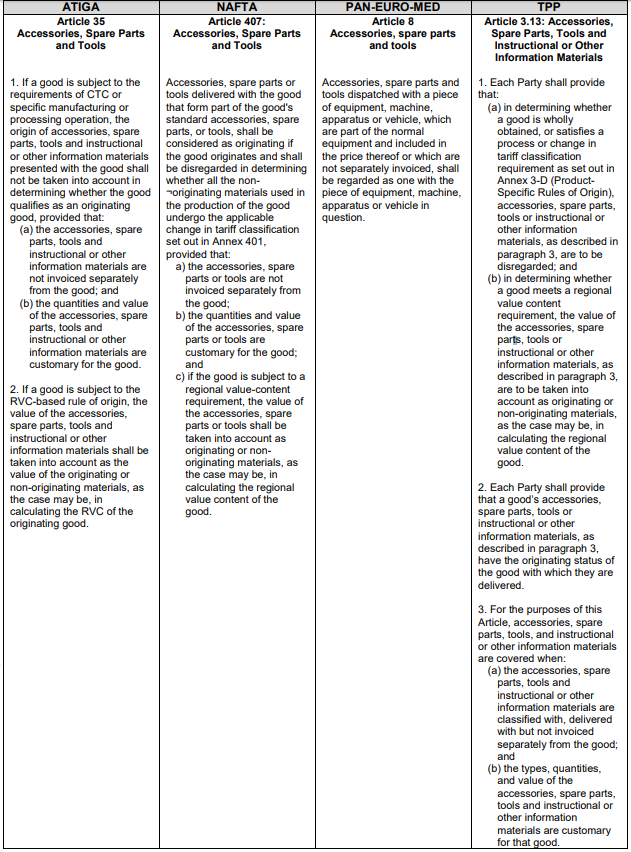
Indirect Materials/Neutral Elements under the FTA
“Neutral elements” or “Indirect materials” means goods used in the production,
testing or inspection of goods but not physically incorporated into the goods,
or goods used in the maintenance of buildings or the operation of equipment
associated with the production of goods, including:
(a) energy and fuel;
(b) plant and equipment;
(c) tools, dies, machines and molds;
(d) parts and materials used in the maintenance of plant, equipment and buildings;
(e) goods which do not enter into the final composition of the product;
(f) gloves, glasses, footwear, clothing, safety equipment, and supplies; and
(g) equipment, devices, and supplies used for testing or inspecting the goods.
Those are called “indirect materials” in the NAFTA and TPP legislation and
“neutral elements” in the ATIGA and PAN-EURO-MED origin legislations.
Despite the different approach to the origin rule for “neutral elements” in the
PAN-EURO-MED and the ATIGA origin legislations and “indirect materials” in the
NAFTA and TPP origin legislations, it is considered that there is no difference in
the practical application of these rules.
Example:
A part is manufactured in a plant in country A. It is to be exported to country B under A-B FTA.
The rule of origin for this part requires non-originating materials not to exceed 40% of the
final value of the part.
Machines used to manufacture the part, spare parts used in the maintenance of these
machines and the fuel used to run these machines are all originating in a non-FTA third country C.
Similarly, the safety equipment and protective clothing used by the factory workers come from
non-FTA countries.
While calculating the value added rule of origin, the non-originating machines, spare parts used to
maintain them, fuel, safety equipment and protective clothing are disregarded or
calculated as originating (depending on the agreement).
Comparison of Indirect Materials/Neutral Elements
NAFTA and TPP origin legislations
The machines, tools, equipment or other goods not incorporated into the final product are
considered to be “originating materials”, meaning that they are taken into account as originating
elements for the calculation of the regional value content. The use of such materials has no
negative implications for origin determination of change in tariff classification rules since they
are considered as “originating input”.
ATIGA and PAN-EURO-MED origin legislations
It is not necessary to determine the origin of the machines, tools, equipment and other goods
not incorporated in the final product since such elements can be disregarded for origin
determination purposes.
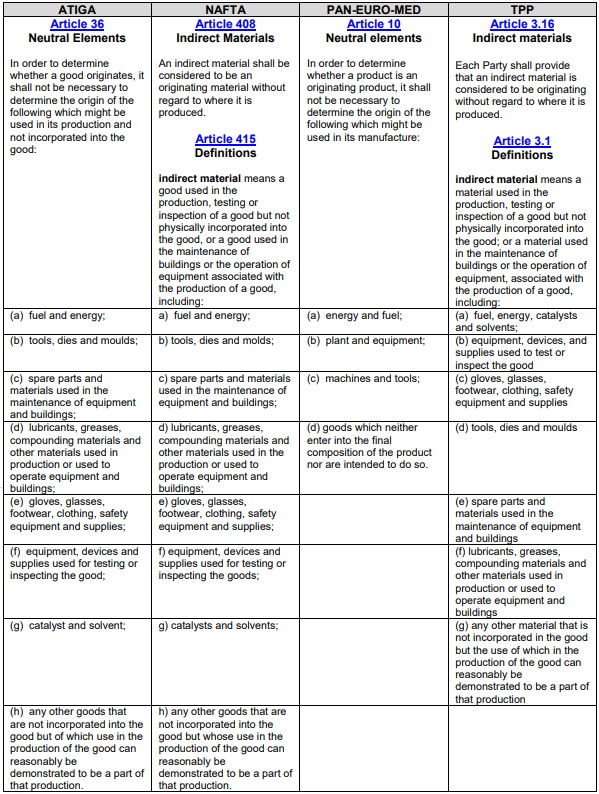
Retrieved from:Comparative Study on Preferential Rules of Origin
HS Classification for “Sets”
Goods put up in sets, consisting of two or more separate constituents,
that are classified in one single heading in accordance with
Rule 3 of the General Rules for the Interpretation (GIRs) of the Harmonized System,
often pose problems to customs insofar as such sets are to be classified according to
the component which gives the set its essential character.
Where the constituents of a set have various origins, this may also pose problems for the
determination of the origin of the set.
Some origin legislations (e.g. NAFTA and ATIGA origin systems) do not mention “sets” at all,
subsuming the origin determination implicitly under the issue of classification according
with the Harmonized System GIRs, whereas other origin legislations deal with this topic in a
separate article (e.g. PAN-EURO-MED and TPP origin systems).
In the PAN-EURO-MED origin system, sets shall be regarded as originating when all
components are originating. Sets comprising originating and non-originating constituents may
also be considered originating provided that the value of the non-originating constituents does
not exceed 15% of the ex-works price of the whole set
(Article 9 of the PAN-EURO-MED origin legislation).
In the TPP Agreement, where a set is classified by application of GIR 3(a) or (b), the originating
status of the set is determined in accordance with the product specific rule of origin that applies
to the set, while where the set is classified by application of GIR 3(c), the set is originating if
each constituent in the set is originating and both the set and the constituents meet other
applicable requirements of Chapter 3 (Article 3.17).
Sets comprising originating and nonoriginating materials may be regarded as originating
as long as the value of the non-originating goods in the set does not exceed 10% of the
value of the set.
Comparison of “Sets”
Here is comparison of “Sets” in the ATIGA, the NAFTA, the PAN-EURO-MED and
the TPP origin systems
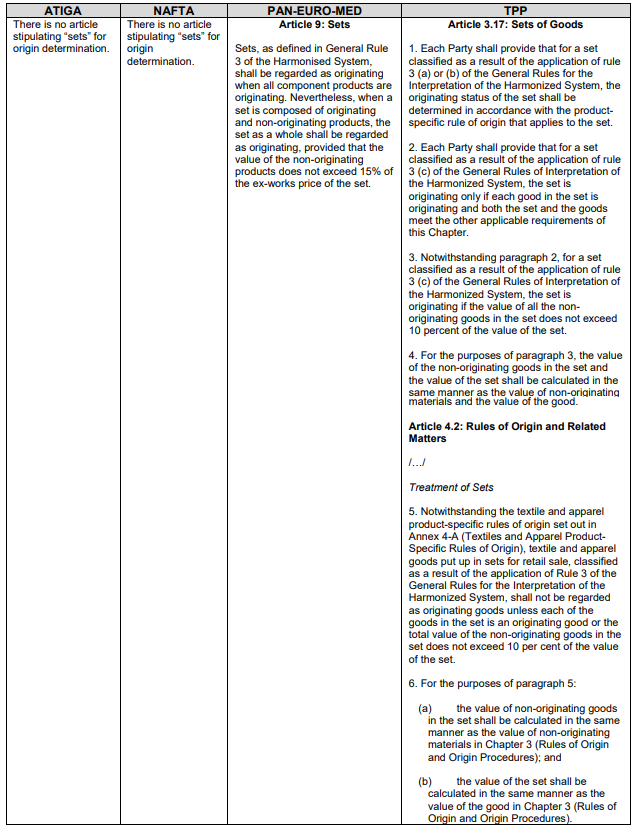
Retrieved from:Comparative Study on Preferential Rules of Origin
GRIs for “Sets”
GRI 1
Classification of merchandise under the HS is in accordance with the
General Rules of Interpretation (GRI’s).
GRI 1 provides that classification is determined according to the terms of the
headings and any relative section or chapter notes.
In certain areas of the HS, sets are specifically mentioned by name.
The only requirements which are to be followed when dealing with a GRI 1 set
are those mentioned in the particular HS provisions describing the set,
relevant chapter and section notes, and the relevant Explanatory Notes (ENs)1.
Sets may appear in the heading text, such as electric generating sets of
heading 8502, HS, or in a subheading text, such as sets of kitchenware of
subheadings 8215.10 and 8215.20, HS.
For subheading sets, GRI 6 applies GRI 1 by requiring that only subheadings
at the same level are comparable. Sets may appear in legal notes, as in chapter 62,
note 3, HS, in which are described sets of garments known as suits and
ensembles, classified in headings 6203 and 6204, HS. Sets may be mentioned
only in the ENs to a particular heading. The rules with regard to GRI 3(b) sets,
discussed below, do not apply to GRI 1 sets.
Taking the kitchenware example mentioned above, subheadings 8215.10.00 and
8215.20.00, HS, provide for sets of assorted articles which are described by
heading 8215, HS. The relevant provisions are as follows:
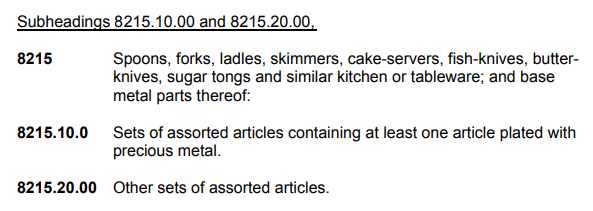
Chapter 82, note 3, HS, and EN 82.15 describe the types of sets to be included in
heading 8215, HS. See HQ 959713, dated May 6, 1997, for an example of how
we classify goods in the provisions of the set of heading 8215, HS.
In that ruling, we held that barbecue utensils, consisting of a fork, spatula, tongs, and
brush, constitute a GRI 1 set under subheading 8215.20.00, HS, as other sets of
kitchen or tableware articles.
GRI 3(B)
The provisions involved in this discussion are as follows:
GRI 3(b)
Mixtures, composite goods consisting of different materials or made up of
different components, and goods put up in sets for retail sale, which cannot be
classified by reference to 3(a), shall be classified as if they consisted of the
material or component which gives them their essential character, insofar as this
criterion is applicable.
EN (VIII) to GRI 3(b)
The factor which determines essential character will vary as between different
kinds of goods. It may, for example, be determined by the nature of the material
or component, its bulk, quantity, weight or value, or by the role of a constituent
material in relation to the use of the goods.
EN (X) to GRI 3(b)
For the purposes of this Rule, the term “goods put up in sets for retail sale” shall
be taken to mean goods which:
(a) consist of at least two different articles which are, prima facie, classifiable in
different headings. Therefore, for example, six fondue forks cannot be regarded
as a set within the meaning of this Rule;
(b) consist of products or articles put up together to meet a particular need or
carry out a specific activity; and
(c) are put up in a manner suitable for sale directly to users without repacking
(e.g., in boxes or cases or on boards).
The term therefore covers sets consisting, for example, of different foodstuffs
intended to be used together in the preparation of a ready-to-eat dish or meal.
Examples of sets which can be classified by reference to Rule 3 (b) are:
(1)
(a) Sets consisting of a sandwich made of beef, with or without cheese, in
a bun (heading 16.02), packaged with potato chips (French fries)
(heading 20.04):
Classification in heading 16.02.
(b) Sets, the components of which are intended to be used together in the
preparation of a spaghetti meal, consisting of a packet of uncooked
spaghetti (heading 19.02), a sachet of grated cheese (heading 04.06)
and a small tin of tomato sauce (heading 21.03), put up in a carton:
Classification in heading 19.02.
The Rule does not, however, cover selections of products put up together and
consisting, for example, of:
– a can of shrimps (heading 16.05), a can of pâté de foie (heading 16.02), a
can of cheese (heading 04.06), a can of sliced bacon (heading 16.02), and a
can of cocktail sausages (heading 16.01); or
– a bottle of spirits of heading 22.08 and a bottle of wine of heading 22.04.
In the case of these two examples and similar selections of products, each item
is to be classified separately in its own appropriate heading.
(2) Hairdressing sets consisting of a pair of electric hair clippers (heading
85.10), a comb (heading 96.15), a pair of scissors (heading 82.13), a brush
(heading 96.03) and a towel of textile material (heading 63.02), put up in a
leather case (heading 42.02):
Classification in heading 85.10.
(3) Drawing kits comprising a ruler (heading 90.17), a disc calculator (heading
90.17), a drawing compass (heading 90.17), a pencil (heading 96.09) and a
pencil-sharpener (heading 82.14), put up in a case of plastic sheeting
(heading42.02):
Classification in heading 90.17.
For the sets mentioned above, the classification is made according to the
component, or components taken together, which can be regarded as
conferring on the set as a whole its essential character.
As EN (X) to GRI 3(b) states, for a group of articles to qualify as a set under GRI
3(b), it must meet three requirements:
(1) consist of at least two different articles which are, prima facie, classifiable
in different headings;
(2) consist of products or articles put up together to meet a particular need or
carry out a specific activity; and
(3) be put up in a manner suitable for sale directly to users without repacking.
If these requirements are met, all articles in the set are classified in the provision
for the article among them that gives the set its essential character.
Because of requirements (1) and (3) are more easily determined and success in
finding a valid set under GRI 3(b) hinges to a large extent on the application of
requirement (2), we will limit our discussion to issues involving the language
contained therein and not discuss requirements (1) and (3) in this publication.
Accounting Segregation/Fungible Goods and Materials
If manufacturers use originating and non-originating materials – even if
these are identical and interchangeable – under normal circumstances,
they are required to stock those materials separately to allow tracing back of
the different origins of materials used in the production of goods.
This ensures that only originating input is used for the manufacturing of
originating goods intended for export under preferences.
The requirement to stock originating and non-originating input material separately
may represent a huge financial burden for the manufactures.
Therefore, provisions on accounting segregation/fungible goods and materials offer
the possibility to use accounting methods to determine the different origins of input
materials or goods which are identical and interchangeable, without any obligation to
physically segregate stocks of non-originating and originating materials or goods.
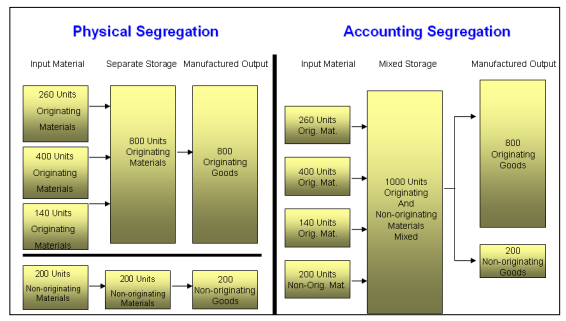
Retrieved from:WCO ORIGIN COMPENDIUM
The method is called “Identical and Interchangeable Materials” in the ATIGA context,
“Accounting Segregation” in the PAN-EURO-MED origin system and “Fungible Goods
and Materials” in the NAFTA and TPP context.
In all four origin legislations the physical mix of non-originating and originating input
materials are limited to ‘fungible’ commodities,
i.e. commodities which are identical and interchangeable.
In the European and the ASEAN origin legislations the application of this method is
limited to materials and not allowed for finished products whereas in the NAFTA and
TPP contexts there are no such distinctions.
According to the NAFTA legislation the use of accounting methods to distinguish
originating and non-originating commodities in the manufacture of originating goods
is permitted. The same applies to the TPP Agreement and it states that the inventory
management selected should be applied throughout the year, however in the
PAN-EURO-MED origin system there is the requirement for a specific authorization by
the customs authorities for the use of such a method and the use of the method is
limited to such cases where keeping separate stocks of originating and non-originating
materials would result in considerable costs or material difficulties.
Such preconditions are not required in the ATIGA, the NAFTA and the TPP contexts.
Comparison of “Accounting Segregation/Fungible Goods and Materials”
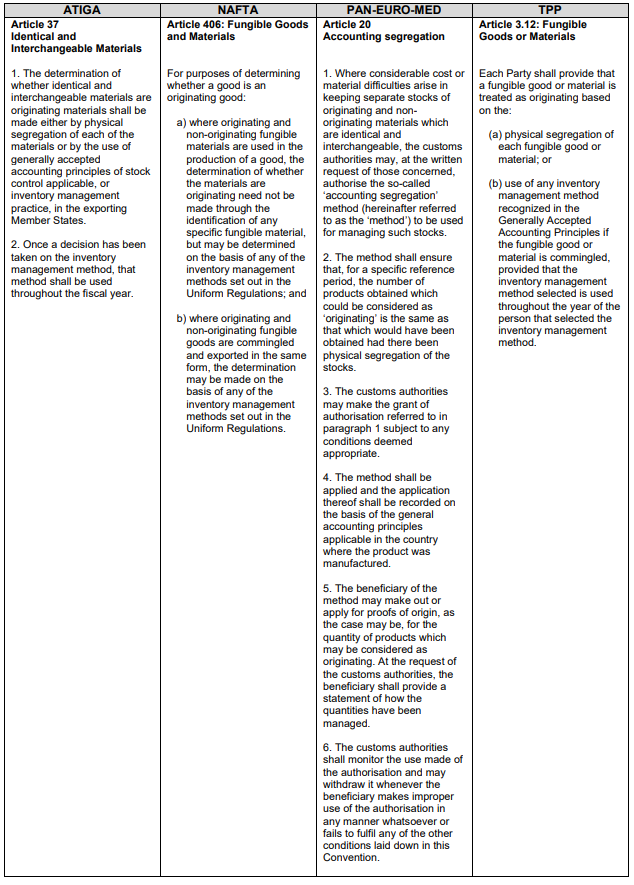
Retrieved from:Comparative Study on Preferential Rules of Origin
Related Study Module on “Accounting Segregation/Fungible Goods”
This study module aims to compare and analyse the features of Rules of Origin (ROO)
provisions of the selected 47 Free Trade Agreements (FTA). This module intends to sort out
the types of various topics of ROO provisions.
The following table is the comparison of accounting segregation / fungible goods in the
selected FTAs.
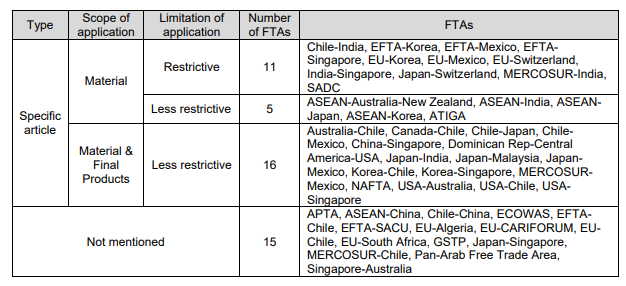
Retrieved from:Comparative Study on Preferential Rules of Origin
Roll-Up principle for Intermediate Material
The “absorption” or “roll-up principle” allows intermediate products to maintain
their originating status when they are used for subsequent manufacturing operations.
The part of all non-originating inputs contained in the intermediate product is
disregarded when assessing the origin of the final good.
This means that if a material which contains non-originating input(s) satisfies the
applicable origin criterion and has acquired originating status, the entire material is
treated as originating when assessing the origin of the subsequently produced good:
The feature of Roll-Up principle
1.the value of the non-originating inputs contained in intermediate materials which have
acquired originating status is counted as originating content in the calculation of value
added criteria;
2.the non-originating parts or materials contained in intermediate materials are not
considered when assessing whether a product-specific rule based on a change of tariff
classification is fulfilled; or
3.the manufacturing processes of non-originating inputs contained in the intermediate
materials are not taken into account when assessing the specific manufacturing or
processing criteria.
The absorption or roll-up principle makes origin rules less restrictive, allowing the use of more
non-originating inputs than are permitted in product-specific rules.
Whereas the absorption or roll-up principle attenuates the restrictiveness of rules of origin for
manufacturing processes within one contracting party of a free trade area, cumulation offers the
same principles to manufacturing processes across contracting parties.
Exsample of Roll-Up principle
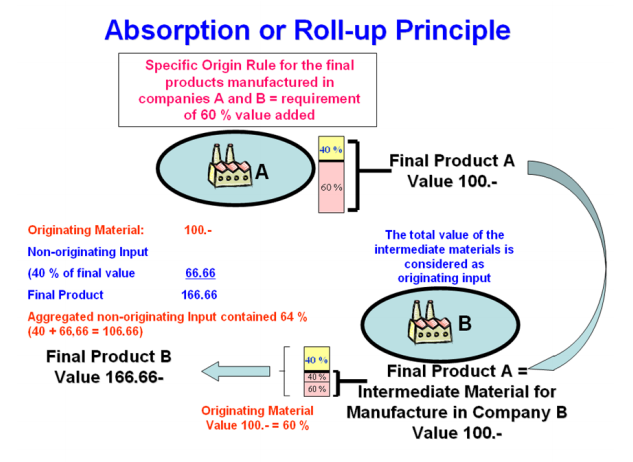
Retrieved from:Comparative Study on Preferential Rules of Origin
The example illustrates how the absorption or roll-up principle works:
A product produced in company A fulfills the origin criterion which requires that 60 % of the
value of the good be added in the free trade area (40 % of the value of the final product maybe
non-originating).
The product is further used as an intermediate material for the subsequent manufacturing of
another good in company B. The absorption or roll-up principle allows the entire good
(from company A) is considered originating when assessing the originating status of the final
product.
Let us assume that the product-specific rule for the product manufactured in company B also
requires that 60 % of the value of the product be added in the free trade area. The intermediate
material is considered to be 100 % originating and it is, therefore, possible to use 40 % of
non-originating materials in the manufacturing of the final product. In this way, the final
product may in practice contain non-originating input of 64 % of the value of the final product,
despite the fact that the origin rule limits non-originating input to 40 % of the value of the
final product.
The absorption or roll-up principle is extensively used in the PAN-EURO-MED context. The
NAFTA legislation also uses the absorption principle, but applies it in a more restrictive manner,
limiting it to the purposes of calculating the regional value content and furthermore excluding its
application in the automotive sector. The TPP Agreement allows for the use of the absorption
or roll-up principle in its general regime-wide origin context. There is no absorption or roll-up
principle in the ATIGA origin system.
Comparision of Roll-Up principle
Here is comparison of “Absorption or Roll-Up Principle/Intermediate Material” in
the ATIGA, the NAFTA, the PAN-EURO-MED and the TPP origin systems
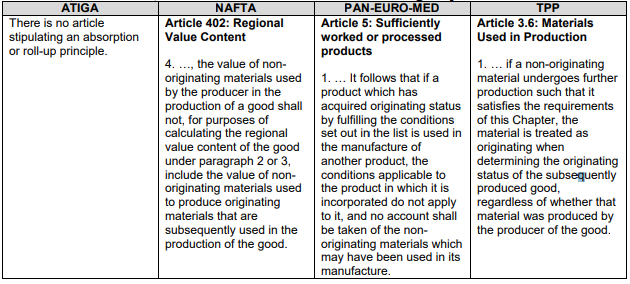
Retrieved from:Comparative Study on Preferential Rules of Origin
This study module aims to compare and analyze the features of Rules of Origin (ROO)
provisions of the selected 47 Free Trade Agreements (FTA). This module intends to sort out
the types of various topics of ROO provisions.
The following table is the comparison of the absorption or roll-up principle/intermediate
the material in the selected FTAs.
